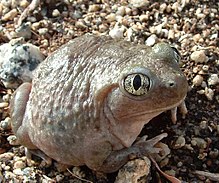
The European spadefoot toads are a family of frogs, the Pelobatidae, with only one extant genus Pelobates, containing six species. They are native to Europe, the Mediterranean, northwestern Africa, and western Asia.

The Scaphiopodidae are a family of American spadefoot toads, which are native to North America. The family is small, comprising only seven different species.

Spea hammondii, also known as the western spadefoot, western spadefoot toad, Hammond's spadefoot, or Hammond's spadefoot toad, is a species of amphibian in the family Scaphiopodidae. It is found in western California (USA) and northwestern Baja California (Mexico). The specific name hammondii is in honor of physician and naturalist William Alexander Hammond.
Western spadefoot or western spadefoot toad is the common name of two different species of toads
Eastern spadefoot or Eastern spadefoot toad may refer to:

Scaphiopus is a genus of North American amphibian commonly referred to as the North American spadefoots, southern spadefoots, or eastern spadefoot toads. They differ greatly from true toads by having eyes with vertical pupils, no parotoid gland, and relatively smooth skin. Their most distinctive feature is a spade-like projection on their hind feet, from which their common name is derived. This projection enables spadefoot toads to dig in loose soils with ease. Its scientific name means ‘spade-foot’ as well, from the Ancient Greek skaphís and pous.

Couch's spadefoot toad or Couch's spadefoot is a species of North American spadefoot toad. The specific epithet couchii is in honor of American naturalist Darius Nash Couch, who collected the first specimen while on a personal expedition to northern Mexico to collect plant, mineral, and animal specimens for the Smithsonian Institution.

Hurter's spadefoot toad or Hurter's spadefoot is a species of American spadefoot toad found in the south central United States ; its range might extend to the adjacent northern Mexico. It was once classified as a subspecies of the eastern spadefoot toad, but it has been granted its own species status. The specific name hurterii is in honor of the Swiss-American naturalist and curator of the St. Louis Academy of Sciences, Julius Hurter.
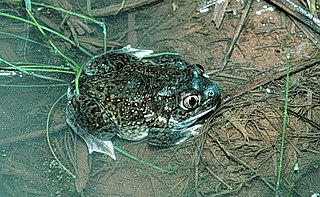
The plains spadefoot toad is a species of American spadefoot toad which ranges from southwestern Canada, throughout the Great Plains of the western United States, and into northern Mexico. Like other species of spadefoot toads, they get their name from a spade-like projection on their hind legs which allows them to dig into sandy soils. Their name, in part, comes from their keratinized metatarsals, which are wide instead of "sickle shaped". The species name translates as buzzing leaf shaped. This refers to the species' distinguishing features; its buzzing mating call, and its leaf-shaped digging metatarsals. It was first described by Cope in 1863.
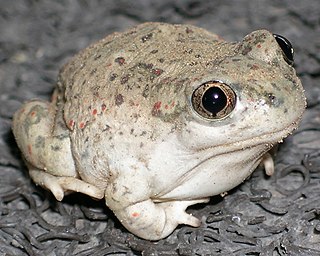
The New Mexico spadefoot toad is a species of American spadefoot toad found in the southwestern United States and Mexico. Like other species of spadefoot toad, they get their name from a distinctive spade-like projections on their hind legs, which enable them to dig in sandy soils. Spea multiplicata can be identified by its wedge-shaped spade. Some sources also refer to the species as the Mexican spadefoot toad, desert spadefoot toad or southern spadefoot toad.

Scaphiopus holbrookii, commonly known as the eastern spadefoot, is a species of American spadefoot toad endemic to the eastern United States. It is not considered a true toad.
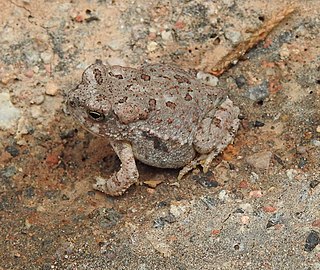
The Arizona toad is a species of toad in the family Bufonidae. It is endemic to the south-western United States, where its natural habitats are temperate lowland forests, rivers and streams, swamps, freshwater marshes, freshwater springs, ponds, open excavations, irrigated land, and seasonally flooded agricultural land.

The Great Basin spadefoot is an amphibian in the family Scaphiopodidae. It is 3.8 to 6.3 centimetres long and is usually colored gray, olive or brown. Great Basin spadefoot toads have adapted to life in dry habitats. They use the hard, keratinized spade on each foot to dig a burrow, where they spend long periods during cold and dry weather. They are opportunistic hunters and will eat anything they can subdue. While their tadpoles have numerous predators, adults are able to produce skin secretions that deter enemies.
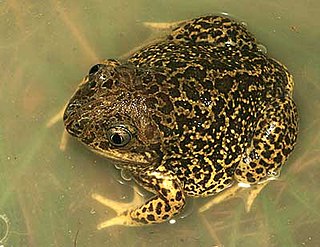
The Pelobatoidea are a superfamily of frogs. They typically combine a toad-like body shape with a frog-like, pointed face. Phylogenetically they stand between primitive frogs on the one side and higher frogs on the other and are therefore – among other things by characteristics of bone construction – in the suborder Mesobatrachia.
